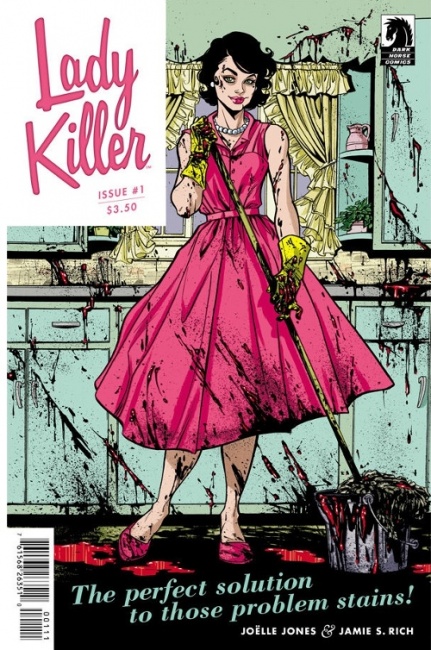We recently caught up with Dark Horse CEO Mike Richardson and two executives deeply involved in the company’s manga program, Director of Licensing--Asia Michael Gombos and Manga Editor Carl Horn, to discuss the state of the comics market in North America and Dark Horse’s place in it. Last week, we published most of the manga portion of the discussion (see “ICv2 Interview: Mike Richardson and the Dark Horse Manga Team, Part 1”).
In this portion of the interview, we focus primarily on the non-manga portions of the market. In Part 1, we talk about the state of the market, the changing gender mix and the new aesthetic in American comics, and ask how Dark Horse is changing post-Star Wars. In Part 2, we talked about Dark Horse’s company-owned characters, its creator-owned projects, hosting ComicsPro, and some special projects around a famed anime director.
What are your thoughts on the current state of the comics and graphic novel market?
Mike Richardson: We’re seeing great success these years. We’re on a three-year trend of our best years ever. We’re ahead of last year, which was our record year. We’re at least at that pace. I haven’t seen early March sales yet, I’ve been out of the office, but we’re having a great year.
In 2013, we saw a 25% increase across the board in sales. All our different divisions had record years, a lot of that fueled by the bookstore market. We’re having tremendous success in bookstores; even our backlist is selling quite well. We just went back to press with over 200 titles.
Why do you think the market is growing, and why, in particular, in the bookstore market?
Richardson: Obviously we want to support our comic shops. They depend more on periodicals than they do on trades, even though that’s an important part of the business (being a retailer, I know that). The comics shops depend on the weekly comics coming in to drive our customers, so that becomes a focus (whatever the latest hot comic is, what are the bestselling comic book titles), because that’s what the customers are coming in and looking for every week. In the bookstores, you have [demand for] longer lifespan, shelf life, and for different titles and, of course, it’s books.
I’ve always said that as much as I love comics, as our comic reader has aged those older readers would rather have a book on a shelf than a comic in a box. We continue to see the struggles that the traditional 32-page pamphlets have. We’ve had months recently where no comic sold over 100,000. Last month I think two comics sold over 100,000, so that number that even Dark Horse used to hit regularly with different titles, basically doesn’t exist much except for the occasional phenomenon like Kirkman’s The Walking Dead, of course, and Saga and a few other titles.
Now we have some nice hits coming out. There’s a new aesthetic in the comic book market, part of it fueled by a growing female readership. Books like Lady Killer have taken off for us. It’s very different than what books drew attention in the mid-90s, say.
What indications are you seeing, based on your sales, that female readership is increasing?
Richardson: A good example would be Lady Killer. Particularly when we go to conventions and talk to people, that first of all we see many more women. We also receive more contact with female consumers, but also the number of female artists and writers is increasing. Certainly with our own books we’re seeing that and I think the market has changed.
If you remember back in the 90s, statistics that I saw showed that over 90% of the readership was male and over 80% of material was sold in comic shops. The new trend started really in the early 2000s because you saw so many teenage girls and younger readers picking up shojo manga. I think that had a direct relationship to the increase of female readers and creators. So many early teen girls were reading shojo, and a certain percentage of them became comics readers. They grow out of the shojo, and then that becomes a part of their reading habits so they look for other books.
Certainly I know for a fact just by the submissions we get here at Dark Horse that we are seeing many more female artists showing us their work at conventions or sending it to us here at Dark Horse. We just saw a sudden explosion of girls drawing, and again, [that was] directly related to shojo. That’s definitely had an impact. If you remember (I know you know this because you look at the statistics), the bookstores’ largest area of growth was in graphic novels during the last decade and that was pretty much fueled by the shojo movement. Manga in general, but shojo as a specific section of the comics offerings.
There’s a willingness to try other things that may not have been there before. You can get something like Brian Wood’s Rebels, which is a historical series, and there’s more readers looking for different subjects and different types of books than the traditional superhero fare that’s dominated comics for so long. Part of that is retailers looking for new areas to bolster sales, and an emergence of new writers and artists that are creating names for themselves, people such as Brian. But also, I think bookstores’ reduced reliance on superhero material has broadened the field.
You mentioned a new aesthetic, is that what you were talking about, non-superhero?
Richardson: Yes, it could be superhero but generally, probably isn’t. Generally, I can say that so many of the Image books that are seeing success are not in the traditional superhero mold. Again, as we broaden the reading base, the industry as a whole is less dependent on superhero material.
Obviously Marvel and DC dominate that area, we know that well, but there are other growing segments of the market. When I talk about this new aesthetic, it’s different types of stories that feel fresh; it’s a new look, a more pop-y look, to the books, different color palettes. There’s just this new feel that seems to be creating a feeling of freshness in the marketplace and readers are responding. Retailers and readers are responding to that look and that feel. We’re ready for some change.
We have started looking at graphic novel material in three big segments (and kids): manga, "author" (creator-owned stories), and superhero or "genre" (corporate-owned IP and universes involving many creators (see "January 2015 BookScan--Top 20 Adult Graphic Novels"). You had a big change in the last year ending your relationship with Lucasfilm for Star Wars and you have this changing marketplace, is the mix between those three areas changing for Dark Horse?
Richardson: We basically have four areas in the company of publishing. We have the licensed books, the creator-owned books--the Mignola’s, Frank Miller, and Eric Powell, Matt Kindt, which remain the core of our company; we have the manga section, and we have company-owned characters. Creator-owned is and always has been the focus.
Obviously the licensed books, we do that very well and we’ve had great success with that. Losing Star Wars? Obviously we didn’t like it. I said at ComicsPro that I’m not going to talk about it anymore because I keep getting asked about it. People have trouble believing this, but it was about 5%, or maybe as high as 6% to our bottom line, so we’ll survive that fine, particularly when we see tremendous increases in our overall sales and the fact that we’re a very diverse company.
We have different divisions. We have a film division--we have a film and a television series shooting right now. We have the toy division with products like Game of Thrones, and they’ve never sold better. We have the publishing which is divided in two areas. I always hate that Diamond pie chart because it leaves out so many of our products and gives the wrong indication. When we’ve sold, for instance, 700,000 copies of Zelda at $35 a book (see "Dark Horse Videogame Books"), you can do the math, we’ll end up selling a million copies of that book and it won’t be counted. That isn’t an accurate reflection of a company’s overall strength and power in the marketplace.
But is the mix changing? Are you doing more in some of these other areas and less with licenses these days than you were a year or two ago?
Richardson: No, not really. You have to understand that if we were going to lose Star Wars, I started preparing a year before that to make up that particular market share and we will have that and we will have some stunning announcements this year.
Click here to go to Part 2.

State of the Market, Changing Gender Mix, More
Posted by ICv2 on March 16, 2015 @ 4:44 pm CT




